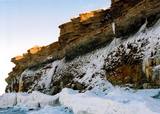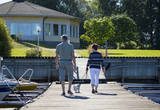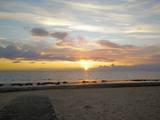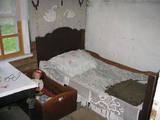| Нo | Название | Описание |
|---|---|---|
|
Die mächtigste Steilküste im Baltikum (bis zu 24 m hoch). In den kalten Winter werden hier phantastische Gletscherstürze entstanden. Pakri Leuchtturm. |
||
|
Saimniecība “Lejaskroķi” atrodas Abavas senlejā. Tajā nodarbojas ar truškopību. Saimnieku aprūpē ir ap 500 trušu, kā arī kazas un mājputni. Viesojoties saimniecībā, viesi varēs samīļot un pabarot trusīšus, kā arī apskatīt kazlēnus, kam ļoti patīk cilvēku uzmanība. Dzīvnieciņus iespējams apskatīt, iepazīt un samīļot, kā arī pabarot. |
||
|
Tūrisma gide Ineta Jansone piedāvā ekskursijas grupām uz Ķemeriem un iepazīstina ar Ķemeru kūrorta vēsturi. Kopš seniem laikiem Ķemeri slaveni ar to, ka šeit ir daudz sērūdeņu avotu un ārstnieciskās dūņas. Šurp brauca ārstēties kopš 19. gs. sākuma. 1838. gadā Ķemeros nodibināja kūrortu. Ķemeru kūrortā ārstēja ādas un kaulu slimības, kā arī gremošanas un nervu sistēmas slimības. 1877.g. izbūvēja dzelzceļa līniju Rīga - Tukums, bet 20.gs. sākumā tika ieviesta tiešā dzelzceļa satiksme ar Maskavu. Kūrorts bija ļoti populārs un katru gadu arvien vairāk viesu brauca šurp ārstēties. Īsi pirms I Pasaules kara atklāja elektriskā tramvaja satiksmi starp Ķemeriem un jūru - Jaunķemeriem. Ķemeri atrodas starp purviem un ezeriem, 6 km attālumā no Rīgas jūras līča. |
||
|
Klusā lauku teritorijā un priežu jaunaudzes ielokā atrodas ģimenes uzņēmums ar videi draudzīgu saimniekošanas filozofiju - "LavenderVilla". Teritorijā ir izveidots lavandas lauks un lavandas labirints ar ~ 6000 lavandas stādiem. Saimniecības apmeklētājiem tiek piedāvāts iepazīties ar lavandas audzēšanu, ko izmanto dizaina priekšmetu, ēteriskās eļļas un tējas ražošanai. Papildus tiek piedāvāti naktsmītnes pakalpojumi lavandas un zāļu atpūtas namiņā, pasākumu organizēšana (joga līdzās lavandām, tematiskie pasākumi, kāzu ceremoniju vieta u.c.), pirtnieka pakalpojumi, fotografēšanās iespējas lavandas laukā un lavandas pārtikas produktu degustācijas. |
||
|
Это один из 6 маршрутов путешествий в серии «Насладитесь деревней!», который приглашает посетить «Дары села» – хозяйства и предприятия всевозможных видов и отраслей, которые открыты для посетителей и предлагают экскурсии, попробовать, осмотреть и приобрести свои изделия. Там можно увидеть домашних животных, современные сельские хозяйства, мастерские ремесленников, приобрести сельскохозяйственные продукты – хлеб, мед, домашнее вино и пиво, сыр, ягоды, фрукты, рыбу, мясо, овощи, чаи и другие, выращенные в деревне дары. По дороге можно отобедать в сельских корчмах. Примерное время прохождения маршрута: три - четыре дней, в зависимости от количества выбранных достопримечательностей и времени, отведенного для их осмотра. |
||
|
Талсинский молочный комбинат был основан в 1922-м году путем объединения нескольких молочных заводов. На этой базе позже было создано АО «Талсу пиенсаймниекс», одним из известнейших продуктов которого является сыр «Талсу ритулис». Продукцию АО «Талсу пиенсаймниекс» – молоко, кефир, творог, масло, сыр и другие продукты можно приобрести в находящемся рядом с предприятием магазине „Piena sēta”. |
||
|
Отель расположен недалеко от моря в тихом месте, всего в нескольких минутах ходьбы от центра Экенеса в Расеборге. Рядом находятся рестораны, магазины, железнодорожный вокзал и пляжи. |
||
|
This is a family company in the Madona Administrative District, which offers natural herbal teas and spices. All of the ingredients come from
|
||
|
Во время этого путешествия вы посетите как мастерские ремесленников, так и хозяйства по разведению лошадей, а также различные производства деревенских продуктов, где старинным навыкам нашлось современное применение. Первая остановка - Икшкиле, где уже в самом начале путешествия вы посетите погреб вина из березового сока и попробуете игристое вино из березового сока. В Скривери позвольте удивить себя превращениям молока - здесь, в уютном кафе на главной улице города, готовят великолепное домашнее мороженое как со вкусом клубники, так и со вкусом анчоусов и хрена. В Кокнесе вы сможете пополнить свой гардероб новым кожаным ремнем, сумкой или стильным украшением из кожи. В хозяйстве по выращиванию конопли пройдет небольшая экскурсия и дегустация деликатесов из конопли. Работы мастеров латгальской черной керамики хорошо впишутся и в современные интерьеры. В Аглонском музее хлеба посетителям будет предложена возможность самим испечь буханку хлеба, а во время посещения следующего хозяйства его можно будет дополнить вкусным сыром, который сделан из молока пасущейся на воле Латвийской бурой коровы. Последняя остановка на латвийской стороне - Даугавпилс, с Арт-центром имени всемирно известного абстракциониста Марка Ротко и Даугавпилсской крепостью 19-го века - впечатляющей военной постройкой - как наиболее популярными достопримечательностями. Затем дорога ведет в Литву, где запланировано посещение нескольких традиционных сельских хозяйств. В усадьбе Ильзенберга (Ilzenbergo Dvaras) обустроено биодинамическое хозяйство. Вы сможете попробовать национальное литовское кондитерское изделие – торт шакотис, осмотрите литовский город Аникщяй (Anyksciai), который предлагает прогулочную тропу над верхушками деревьев. В Музее лошадей представлены старинные орудия труда и техника. В продолжении предусмотрено посещение хозяйств, которые знакомят с традиционной литовской кухней и гончарным ремеслом. В коневодческом хозяйстве в Дубингяе (Dubingiai) можно прокатиться верхом на лошади по манежу. В завершении путешествия вы осмотрите уникальный Тракайский замок (14-15 век) и Вильнюс. |
||
|
Расположенная в Лахемааском национальном парке рыбацкая деревня Алтъя впервые упоминается в 1465 году. Это типичная прибрежная деревня, где дома расположены вдоль одной деревенской улицы. Сегодня здесь можно увидеть типичные прибрежные хутора конца 19-го века-Уусталу и Тоомарахва. На мысе Алтъя восстановлены сараи для сетей. В деревне есть качели, национальные блюда предлагает ресторан Altja kõrts/Корчма Алтъя (+372 501 4287, www.palmse.ee/altja-korts) |
||
|
Eine der eindrucksvollen Reliefgestaltungen im Baltikum. Bei Sigulda erreicht das Urstromtal eine maximale Tiefe von 85 m ( Breite ung. 1 km). Schöne Sandsteinaufschlüsse aus dem Devon ist ein Anziehungspunkt. |
||
|
Находится в центре Мадоны. В приготовлении блюд используют фрукты и овощи из собственного хозяйства. Латышская кухня: Холодный свекольный, щавелевый суп и суп с лисичками, серый горох с салом, селедка, ячменная каша со шкварками, грибной соус, варенье (семь видов), круглый год десерт из малины или клубники. Тонкие блины с картофельной, тыквенной, яблочной и рабарбаровой начинкой, сырники. Домашние соки, травяные чаи, коктейли из мороженого. Особое блюдо: Домашний бисквитный пирог со свежими ягодами. |
||
|
This park is located along the shores of the Tērvete River Valley. It is a vast forested area which has been adapted successfully for travellers. In 2004, it was nominated as the most family - friendly destination in the land. There is a web of trails for one-day hikes. Viewing tower on the shore of the Tērvete River, views also from the Tērvete castle hill and Zviedru (Swedish) Hill.
|
||
|
Расположен в 1,3 км к северо-западу от центра Акнисте, в небольшом отвершке Диенвидсусеи. Этот родник как источник здоровья известен с древнейших времен. Рассказывают, что в роднике, вытекающем на восток, вода обладает целительными свойствами. Особенно утром на Пасху, если помыть глаза. Родниковая вода содержит соединения железа, о чем свидетельствуют коричневые наросты (результат воздействия железобактерий). Рядом с родником есть камень с небольшим углублением, предположительно - старинный культовый камень. На краю оврага растет святая липа. Святой источник Салтупе можно обоснованно считать одним из самых значимых родников Латвии. |
||
|
Как большое населенное место Саулкрасты начало образовываться в конце 19-го века, когда маленькие рыбацкие поселки – Нейбаде, Петерупе и Катринбаде стали популярным местом для отдыха и купания жителей Риги. Это вскоре поспособствовало строительству дач. На развитие курорта также повлияло открытие водного сообщения между Ригой и Саулкрасты в 1905-м году. Были построены новые курзалы, рестораны и развивалась другая инфраструктура, связанная с курортом. В летнее время отдыхающие могли развлечься на мероприятиях, баллах и концертах с участием рижских оркестров. Следующим этапом развития курорта стало шоссе и железнодорожная линия между Ригой и Саулкрасты, построенные в 30-х годах 20-го века. Советское время охарактеризовалось строительством домов отдыха, санаториев и новыми дачными домиками. Саулкрасты получают статус города. Сегодня Саулкрасты привлекают не только белым песчаным пляжем, но и различными ежегодными общественными мероприятиями, тропой Солнечного заката и Белой дюной, уникальным музеем велосипедов, Морским парком и местом для купания «Центр», площадью Саулес и другими объектами. |
||
|
Pļaviņās, pie Daugavas ielas, Daugavas krastā uz laukakmeņiem novietots plosta modelis ar stendu (2011. gads, biedrība „Kopsolis”), kur izlasāms stāsts ar plostnieka atmiņām un aplūkojamas vēsturiskās plostnieku fotogrāfijas. Daugavas posms starp Pļaviņām un Koknesi bija visgrūtāk pārvaramais plostnieku šķērslis ar krācēm un līdz 20 m augstiem, klinšainiem upes krastiem. |
||
|
Построенная в начале 19-го века жилая рига с земляным полом - старейшее здание музея. Жилое помещение с комнатами пристроено во второй половине 19-го века. Во дворе есть еще баня по-черному, летняя кухня, амбар, подвал, каретный сарай и столовая (бывший хуторской хлев). Во всех этих помещениях экспонируются старинные орудия труда и предметы обихода. По предварительному заказу предлагаются традиционные деревенские блюда, можно принять участие в работе мастерских. |
||
|
Kolga Manor with its impressive territory, several buildings and antique feel will not leave you unmoved! Kolga Manor was first heard about in 13th century but the manor we see nowadays was built style of Baroque in 17 - 18th century but in 1820's it was re-built in the style of Classicism. From the end of 17th century until 20th century it was the biggest Estonian manor. Now in these buildings is a guesthouse, a restaurant, conference centre and a museum. It's possible to hire a guide. |
||
|
Находится на северо-восточном берегу Малого Лудзенского озера. В экспозиции под открытым небом представлен жилой дом крестьянина (курная изба), жилое здание, ветряная мельница, овин и мастерская керамиста Поликарпа Вилцанса. Здесь проводятся различные мероприятия, связанные с ремесленничеством и культурными событиями. Рядом с музеем находится пристань с плотом для прогулок по Малому Лудзенскому озеру (предварительная заявка) и место для отдыха. |
||
|
Dabas taka atrodas Zaķumuižā un ved cauri vecajam muižas parkam, pa ceļam iespējams aplūkot simtgadīgus kokus, dažādus augus, kā arī dažādus kukaiņus, putnus. Taka ir veidota kā mācību taka un to veidojusi Zaķumuižas pamatskolas skolotāja. Taka ir 1,5 km gara. Tai ir vidējas grūtības pakāpe: takas reljefs ir samērā vienmērīgs, mērens, izņemot atsevišķus posmus (daži stāvumi un kritumi, dažviet nelīdzens reljefs), tāpēc īpaša fiziska sagatavotība pirms takas iziešanas nav nepieciešama. Vietās, kur reljefs ir stāvāks, izvietoti roku balsti, bet pāri muižas dīķu sistēmas ūdeņiem uzcelti divi tiltiņi.
|
||
























